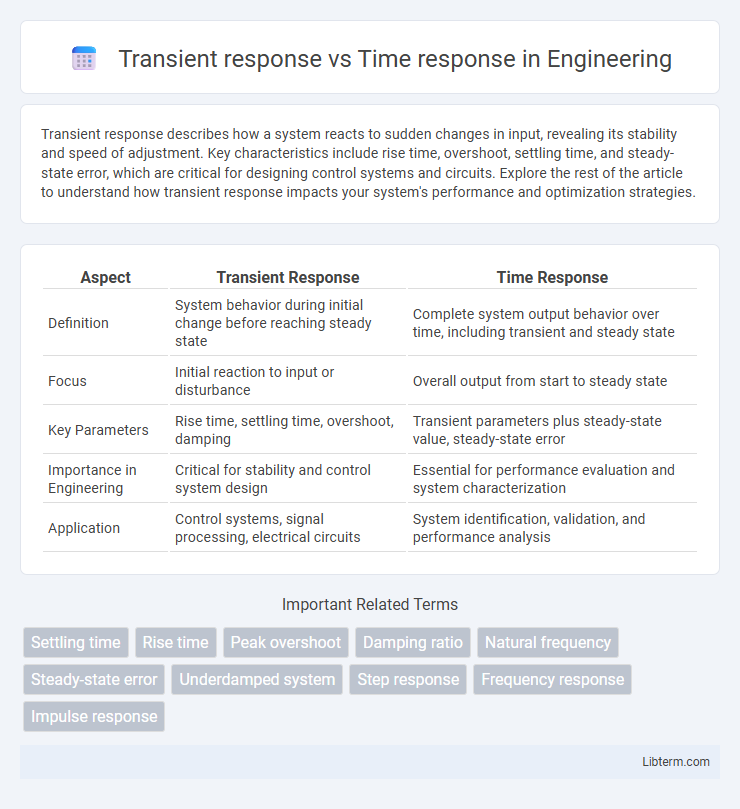Transient response describes how a system reacts to sudden changes in input, revealing its stability and speed of adjustment. Key characteristics include rise time, overshoot, settling time, and steady-state error, which are critical for designing control systems and circuits. Explore the rest of the article to understand how transient response impacts your system's performance and optimization strategies.
Table of Comparison
| Aspect | Transient Response | Time Response |
|---|---|---|
| Definition | System behavior during initial change before reaching steady state | Complete system output behavior over time, including transient and steady state |
| Focus | Initial reaction to input or disturbance | Overall output from start to steady state |
| Key Parameters | Rise time, settling time, overshoot, damping | Transient parameters plus steady-state value, steady-state error |
| Importance in Engineering | Critical for stability and control system design | Essential for performance evaluation and system characterization |
| Application | Control systems, signal processing, electrical circuits | System identification, validation, and performance analysis |
Introduction to Transient and Time Response
Transient response is the behavior of a system immediately after a change in input, characterized by rapid variations before reaching a steady state. Time response encompasses the entire output behavior of a system from the initial change to when it settles, including both transient and steady-state phases. Analyzing transient response is crucial for understanding system stability and performance during the initial adjustment period.
Defining Transient Response
Transient response refers to the behavior of a system immediately after a change in input, typically characterized by rapid adjustments before reaching steady state. It involves how quickly and accurately the system reacts to disturbances, including overshoot, settling time, and rise time. Time response encompasses the entire output over time, covering both transient and steady-state phases.
Understanding Time Response in Systems
Time response in systems encompasses both transient response and steady-state behavior, illustrating how a system reacts over time when subjected to an input. Transient response refers to the initial phase where the system output adjusts from its initial state to the desired value, characterized by phenomena such as overshoot, settling time, and oscillations. Understanding transient response is crucial for designing stable control systems that achieve desired performance specifications without excessive delay or instability.
Key Differences: Transient vs Time Response
Transient response refers to the system's behavior immediately after a disturbance or input change, capturing initial fluctuations before settling. Time response encompasses the entire output signal of the system over time, including both transient and steady-state behaviors. The key difference lies in transient response focusing on short-term dynamics, while time response considers the full period from input to equilibrium.
Importance in Control Systems
Transient response and time response are critical metrics in control systems that determine how quickly and accurately a system reacts to input changes. The transient response highlights the system's behavior during the adjustment period, revealing overshoot, settling time, and stability characteristics essential for tuning controllers. Assessing the complete time response, which includes transient and steady-state phases, ensures optimal performance and robustness in applications like robotics, aerospace, and industrial automation.
Factors Affecting Transient Response
Transient response is influenced by system parameters such as damping ratio, natural frequency, and gain, which determine the speed and stability of the system's reaction to input changes. Time response encompasses both transient and steady-state behavior, with transient response specifically characterized by overshoot, settling time, and rise time shaped by system inertia and feedback control. External disturbances, initial conditions, and component nonlinearities also significantly impact the transient response in dynamic systems.
Steady-State vs Transient Behavior
Transient response characterizes a system's behavior immediately after a change or disturbance, highlighting temporary deviations before stabilization, while time response encompasses the entire signal evolution from initial to steady-state conditions. Steady-state behavior refers to the system's output after transient effects have decayed, representing consistent and predictable performance. Understanding the difference between transient and steady-state responses is critical for designing stable control systems and optimizing dynamic performance.
Methods to Analyze Time Response
Methods to analyze time response include step response analysis, impulse response analysis, and ramp response evaluation, each characterizing how a system reacts over time to specific input signals. Transient response techniques specifically examine behaviors like overshoot, settling time, and rise time immediately following sudden changes in input. Tools such as Laplace transforms and time-domain simulations provide detailed insights into both transient and steady-state performance of dynamic systems.
Practical Applications and Examples
Transient response characterizes a system's behavior immediately after a disturbance or input change, revealing critical details about stability and damping in electrical circuits and mechanical systems. Time response, encompassing both transient and steady-state phases, provides a comprehensive analysis crucial for designing control systems in robotics and automotive suspensions. Practical applications include tuning PID controllers for optimal transient response in industrial automation and evaluating time response in HVAC systems for energy-efficient climate control.
Conclusion: Choosing the Right Response Analysis
Selecting the appropriate response analysis depends on the specific requirements of system evaluation and design. Transient response analysis is crucial for assessing system behavior during sudden changes or disturbances, emphasizing stability and speed of settling. Time response analysis provides a broader view of system performance over time, including steady-state behavior, making it essential for comprehensive control system optimization.
Transient response Infographic

 libterm.com
libterm.com